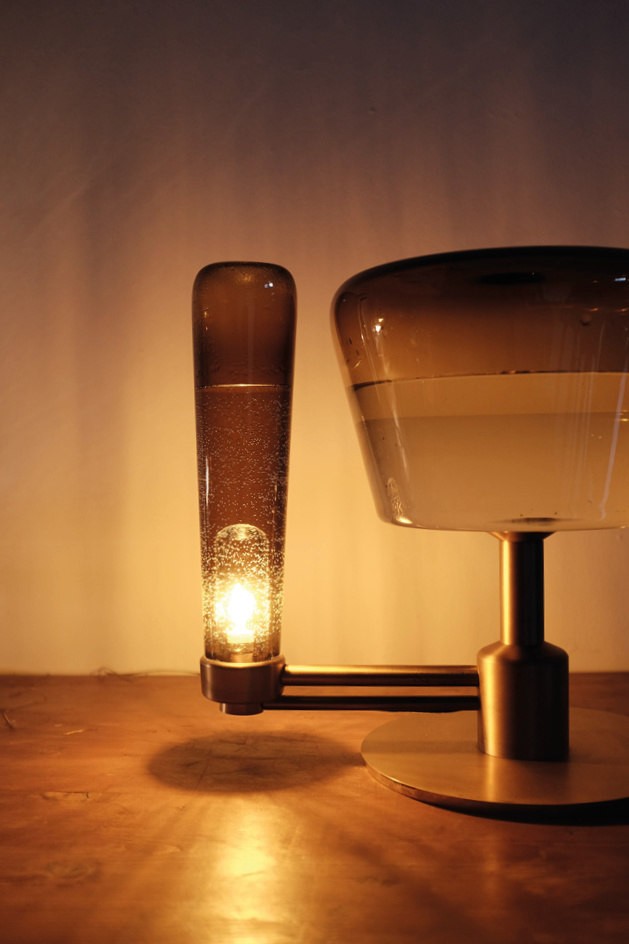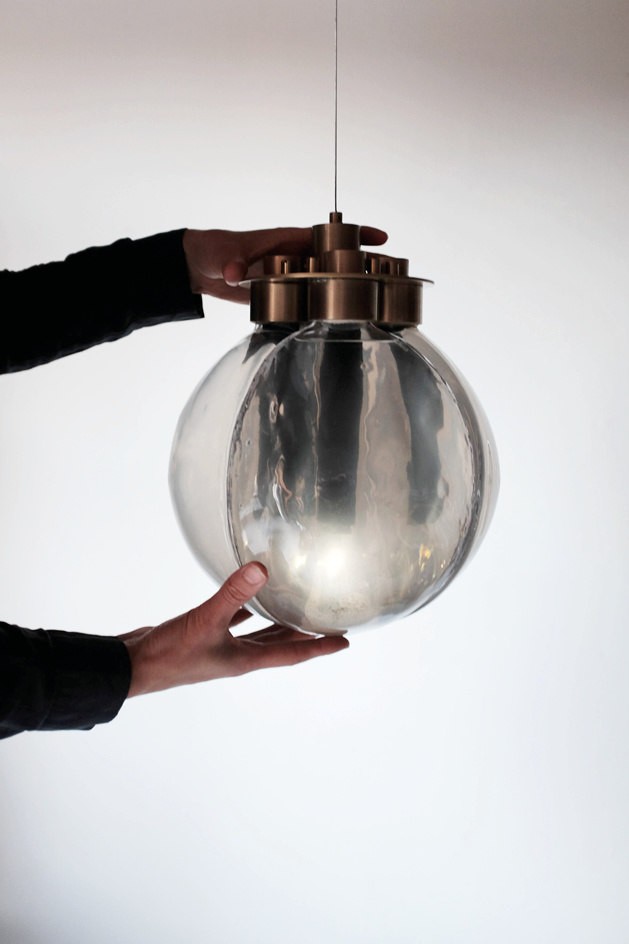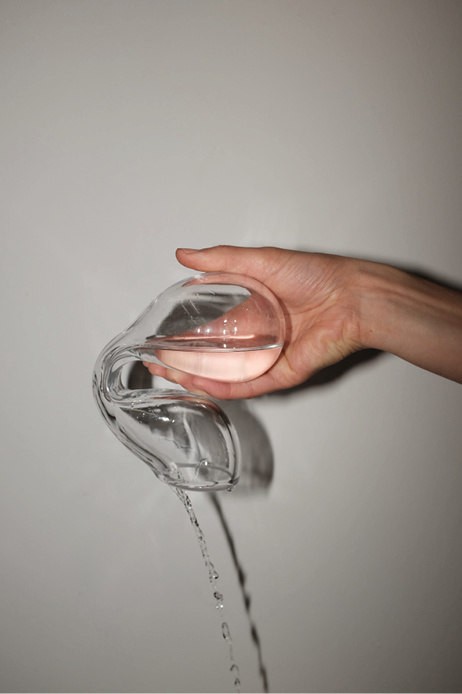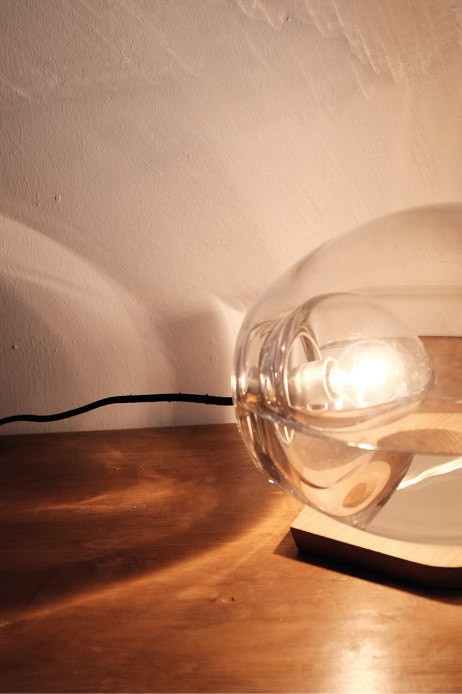
Natural curiosity
Dutch designer Teresa van Dongen creates lamps. And uses scientific knowledge to bring them to light. Behind these creations is an irrepressible passion for research and love of experimentation as well as the desire to ensure that scientific findings don’t just gather dust in a lab.
Birte Mußmann (interview) & Linus Bill (photo), Teresa van Dongen (video)
Teresa von Dongen’s small studio is in a former warehouse in Amsterdam’s Houthaven neighborhood. In the room that the Dutch native shares with an artist friend, many glass jars, plastic containers and test tubes are clustered on a table and in shelves alongside an easel. The result is a charming hodge-podge that mingles the atmosphere of a chemistry lab and an artist’s studio. As you learn about the 29-year-old’s designs, it quickly becomes apparent that this blend of science and creativity is the common thread that runs through Teresa van Dongen’s life. For one thing, it mirrors her fields of study: After finishing school, she initially chose to pursue a degree in biology. But after two years, she transferred to the Design Academy in Eindhoven and graduated in 2014. Now, she’s merging her knowledge of the two areas in the form of lamps comprising a natural light source and flowing, organically shaped glass vessels of her own design. The results are not mass-produced but rather projects and installations resulting from interactions with like-minded souls and the curious. In this interview, the creative scientist reveals more about materials, natural phenomena and the intentions behind her designs.
The Audi Magazine: You started studying biology before switching to the Design Academy. What made you decide to change direction?
Teresa van Dongen: Studying biology was fascinating but often too rigidly theoretical. Most of the program was taken up with reading specialist literature. And standing around desks for long periods to analyze something through the microscope. At some point, it began to feel monotonous. I wanted to put what I had learned into practice and experiment to discover new things—in other words, more learning by doing. After I gave up biology, I was involved in theater scenography for a short while, and my application portfolio for the Design Academy grew out of that. Luckily, I was accepted. The combination of research, design and craftsmanship was perfect for me and my aspirations.
How would you describe those aspirations?
Research often stays behind closed doors or the findings are only made available to a very narrow group of people. Which is a terrible shame, considering that there are so many amazing phenomena that have already been scientifically probed and new things are always being discovered. I want to play a part in changing that—by marrying science and design. These two different disciplines pave the way to an onlooker being able to interact with an object. Movement, for instance, triggers illumination in one of my lamps (Ambio). Gently swinging this lamp creates waves, circulating oxygen, which in turn provides bioluminescent microorganisms in the water with the oxygen they need to start glowing. The design and physical laws of motion bring this captivating natural phenomenon to life. It’s literally tangible, in fact—the lamp needs to be touched to light up. This is a key aspect in playfully bringing home to people the scientific research my work is based on.
Staying on the subject of scientific knowledge: A lot of it is in a state of flux. Which probably makes it vital for you to think outside your own disciplinary box.
Yes, that’s true. I try to collaborate with other scientists, artists or designers as often as possible and enter into a dialog. Of course, exchanging ideas helps—and every now and then you need a new perspective to unleash fresh impetus or resolve a knotty problem. My work isn’t confined to the studio but also takes place in scientific labs and occasionally in a glass-blowing workshop. There, too, I’m always meeting exciting people.
You’ve taken workshops at the glassworks to learn new techniques and, from time to time, simply taken the unconventional route of trying things out. Where does your love of experimentation come from?
I was always naturally inquisitive and had a really strong urge to discover things. Even as a child, experiments enthralled me. To some extent, that’s thanks to my father, who would amaze us kids by bringing small marvels into our everyday lives. I still remember a block party where he assembled a kind of laboratory glass setup. He allowed a liquid to flow through it that gradually changed color. He played his cards close to his chest, but that little chemistry experiment left a lasting impression.

Spark of Life: When electrochemically active bacteria clean waste water, their metabolic process emits a small electrical current. Teresa van Dongen researched these specific bacteria in order to harness the electricity they produce for household use. Her findings led her to develop the Spark of Life model—a lamp that doesn’t need to be plugged in to light up. These “living lamps” need to be fed a teaspoon of acetate every two weeks and topped up with fresh water every month.

Lumist: Although energy is a precious commodity, we often don’t notice when it is being wasted. The Dutch designer looked for a way to harness the heat generated by halogen lamps and created Lumist—a lamp and humidifier rolled into one. The heat from the bulb keeps the surrounding water just below the boiling point so that it evaporates. More water is constantly provided by the adjacent reservoir.



Ak (from the series Sue, Lo and Ak): Water is often used like a disposable product even though the precious liquid is the source of all life. By treating water as you would a good wine, Teresa van Dongen emphasizes the value of this resource. These vessels have been shaped so that when someone drinks or pours from them, the water keeps moving and swirling.

Lumi: This lamp exemplifies the contradictory properties of water and light in the form of a glass droplet. It reflects, magnifies and spreads its own light—and that of the sun. As a result, the lamp looks different depending on the time of day and natural lighting conditions.
In the meantime, you’ve grown up and gained a lot of experience. So it probably takes far more than a little experiment to make your jaw drop. What projects impress you today?
There are lots of areas that I find exciting—space exploration, for instance. Even though it’s not exactly obvious, this discipline produces findings that are valuable to me. A lot of projects in this field focus on generating energy in unconventional ways and creating a closed loop so it’s never lost. In the remoteness of space, survival depends on conserving resources. After all, the crew of a space station can only make use of what’s on board. Researchers are constantly developing new ways to recover energy. Here, again, the problem is that the focus is often on the end result. Secondary findings that would work very well on Earth, for instance, receive little attention. Which is a real pity, because it was just such a contribution that brought me into contact with someone who helped me make progress on researching the bacteria for my Spark of Life “living lamp.” A lecture about using urine to produce energy planted the seed in my mind.
Materials, functionality, design—what presents the biggest challenge in your projects?
A lot of my projects are studies and so are still at the conceptual stage. The difficulty comes in taking them to the next level and making them a bit more low-maintenance for use in homes. Adding or removing water, introducing new bacterial cultures—all of that is admittedly not all that easy. Which is why, for the time being, I mainly showcase my ideas at exhibitions or events. But I would like to change that at some point in the future. Even so, I don’t want all my designs to be mass produced. Some of my works will probably stay unique pieces or reserved for people eager to grapple with its scientific background and patient enough to follow the care instructions to the letter. It’s no simple matter to maintain the delicate equilibrium in a micro biosphere such as the one responsible for illuminating Ambio. But Spark of Life is already much more accessible with its one weekly maintenance. For me, the biggest challenge isn’t finding the right design. It’s getting my idea to survive in the world outside my studio and become part of a home. That’s why I always try to tell a little story with my pieces.
So you’re not just a scientist and a designer but also tell stories for the benefit of science?
Artworks such as paintings usually adhere to this principle. Weaving stories around my pieces lends them an artistic touch. When you visit a gallery or show friends your new favorite artwork in your home, the narrative starts a conversation. I aim to achieve the same thing with my works—prompting onlookers to engage, discuss, speculate and question.
Where do you get your inspiration?
I try to keep constantly up to speed with exciting new research projects in the fields that interest me. To do that, I read specialist publications as well as attend lectures and trade shows. These often lead to intriguing conversations and, every now and then, collaborations. I find interdisciplinary approaches particularly fascinating. Exchanging ideas is essential to opening up new perspectives that I then translate into my work. But sometimes, all I need to do is go downstairs and chat with other artists, designers or even an electrician. A lot of creative people work in the building where my studio is. We’re very supportive and like to bounce ideas off each other.
Light is an essential component of your designs. What personal significance does light hold for you?
Using light as an element in my designs stems from my fascination with energy. I’ve always been drawn to how the concept as a whole can be scientifically explained— how it’s produced, transferred and how we can use it. Light is a good way of making energy visible. Plus, of course, it’s a beautiful design element. While it’s also possible to make energy tangible through movement, it’s far more difficult to translate it into a common, functional form. Movement tends to lend itself to art, and light to the category of design.
Ambio: Anyone who has seen blue phosphorescence on the ocean at night knows how magical it looks. The phenomenon is caused by bioluminescent micro-organisms in seawater that glow when the rolling of each wave provides them with oxygen. This concept inspired the designer to combine her passions for biology and design into a bioluminescent light installation. Ambio balances two weights with a glass tube half filled with artificial seawater, which contains a carefully selected species of these unique micro-organisms. Gentle swinging activates the illumination.
To a certain extent, science dictates the form. How do you go about visualizing your ideas?
I like to visualize my ideas first on paper. That helps me to think about the various elements and get an initial feel for them—whether all the pieces fit together and the processes will theoretically work. Occasionally, I work using computer programs, especially when preparing projects for competitions or exhibitions That makes things a lot more precise for the onlooker because even the tiniest details can be accurately portrayed.
Do digitalization and cutting-edge technologies such as artificial intelligence impact other areas of your work?
Nowadays, no one can completely escape these developments. I make use of digital technologies for communicating with the outside world and presenting my work—for instance, in competitions. On the whole, my projects are better categorized as a “return to the roots,” although I don’t like that expression very much. The energy sources for most of my projects are natural, so adding digital or technological tools would be at odds with that. A technological component would have the same effect as an opaque sheet covering the project, making it harder to grasp or diluting the process at work.
How does that manifest itself in your projects?
In the Ambio model, for one, I initially studied the bioluminescent bacteria in a lab. They need oxygen to make them glow. This was provided by means of an electronic pump. For my lamp, I wanted to find a natural way to activate this process. Because I found it somehow unsatisfying that a natural process needed technological, electronic aids to kick-start it. In nature, this phenomenon is triggered by the movement of the waves, which incorporates oxygen into the water. The lamp mimics this process. A glass vessel contains the liquid with bacteria as well as oxygen. By setting the vessel gently in motion, you create waves. The result is this naturally produced light. So you see, biology is a true natural science.
In conclusion, let’s look a bit ahead. What are your hopes for the future?
I hope that people keep their natural curiosity and never stop trying to understand things and questioning them. And that doesn’t mean always just looking things up online but also entering into personal exchanges with others. We need to increase awareness of the planet we live on. Knowledge is a good key to that door because it not only promotes understanding but can also help people connect more with nature. I can only speak from my own experience of this. It’s not just children who are keen explorers—we all are. Sometimes we just need it coaxed out of us.